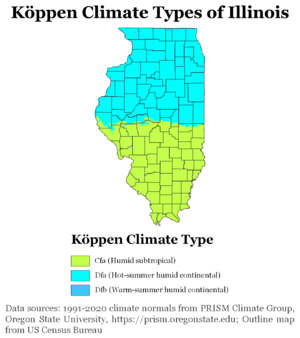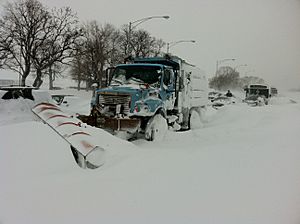Climate of Illinois facts for kids

The Climate of Illinois describes the weather conditions and extreme temperatures found in the state of Illinois, United States.
Because Illinois stretches for almost 400 miles (640 km) and is in the middle of the continent, its weather can change a lot. Most of Illinois has a humid continental climate (this means hot, sticky summers and cool to cold winters). But the southern part of the state, from about Springfield south, has a humid subtropical climate. This means winters there are milder.
On average, Illinois gets between 35 inches (890 mm) of rain in the north and 48 inches (1,200 mm) in the south each year. Normal yearly snowfall is over 38 inches (0.97 m) in Chicago, but less than 14 inches (0.36 m) in the south. The hottest temperature ever recorded in Illinois was 117 °F (47 °C) on July 14, 1954, in East St. Louis. The coldest was -38 °F (-39 °C) on January 31, 2019, in Mount Carroll.
Illinois has about 50 days with thunderstorms each year. This is a bit more than average for the United States. Illinois also gets many tornadoes, with about 54 happening every year. This means about 9.7 tornadoes per 10,000 square miles (26,000 km²) annually. The deadliest tornado in U.S. history happened mostly in Illinois. The Tri-State Tornado of 1925 caused many deaths across three states. In Illinois, 613 people sadly passed away.
Temperatures

Big cities often feel about 2 °F (1 °C) warmer than the countryside. This is called the urban heat island effect. It is most noticeable at night.
Heat
The 1995 Chicago heat wave was a very serious weather event. In just five days, 525 people became very sick and passed away. During this time, night temperatures stayed as high as 84 °F (29 °C). Daytime temperatures reached up to 106 °F (41 °C). The most deadly heatwave in U.S. history also affected Illinois in July 1936. During this event, 2,656 people in Illinois sadly died.
Cold
Temperatures can drop very quickly in Illinois. This happens when a strong cold front moves through the state. For example, on December 20, 1836, temperatures fell 40 °F (22 °C) in just minutes. People even said chickens froze in their tracks!
Before 2019, the official record low was -36 °F (-38 °C). This was recorded in Congerville on January 5, 1999. However, in 2019, the January North American Cold Wave hit Illinois. This brought a new record low temperature of -38 °F (-39 °C). It was recorded on January 31, 2019, in Mount Carroll.
| City | Jan | Feb | Mar | Apr | May | Jun | Jul | Aug | Sep | Oct | Nov | Dec |
|---|---|---|---|---|---|---|---|---|---|---|---|---|
| Cairo | 41/25 | 47/29 | 57/39 | 69/50 | 77/58 | 86/67 | 90/72 | 88/69 | 81/61 | 71/49 | 57/39 | 46/30 |
| Chicago | 31/16 | 35/20 | 47/29 | 59/39 | 70/48 | 80/58 | 84/64 | 82/63 | 75/54 | 62/43 | 48/32 | 35/21 |
| Edwardsville | 36/19 | 42/24 | 52/34 | 64/45 | 75/55 | 84/64 | 85/59 | 86/66 | 79/58 | 68/46 | 53/35 | 41/25 |
| Moline | 30/12 | 73/50 | 83/60 | 86/64 | 84/62 | 76/53 | 64/42 | 48/30 | 34/18 | |||
| Peoria | 73/51 | 82/60 | 86/65 | 84/63 | 77/54 | 64/42 | 49/31 | 36/20 | ||||
| Rockford | 71/48 | 81/58 | 84/63 | 82/61 | 75/52 | 62/40 | 47/30 | 33/17 | ||||
| Springfield | 74/53 | 83/62 | 86/66 | 84/64 | 78/55 | 67/44 | 51/34 | 38/23 | ||||
Precipitation
The amount of rain and snow in Illinois changes from north to south. The southern tip gets over 48 inches (1,200 mm) each year. The northern part gets just under 32 inches (810 mm). May and June are usually the wettest months. Flooding is the most damaging weather problem in the state.
More rain tends to fall downwind of cities. This is because the warmer city air helps create more rainfall. Near Lake Michigan, the lake makes winter precipitation heavier along its south shore. This is called lake effect snow. In summer, the cooler lake air can reduce rainfall near the shore.
Snowstorms
While Chicago usually gets over 38 inches (0.97 m) of snow each year, the southern part of Illinois gets less than 14 inches (0.36 m). The winter of 1978–79 was the snowiest on record for Chicago, with 89.7 inches (2.28 m) of snow. The city also had over 80 inches (2.0 m) of snow in 1977-78 and 2013-14.
In the winter of 1830–31, southern Illinois was covered with 3 feet (0.91 m) of snow. Snow drifts were up to 6 feet (1.8 m) tall! Heavy snowstorms that bring more than a normal winter's worth of snow in one day can happen, especially in the southern half of the state. The most snow Chicago ever got in one storm was 23 inches (0.58 m) during the Blizzard of 1967.
Thunderstorms and severe weather
Illinois has about 50 days with thunderstorms each year. This is a bit higher than the average for the United States. Thunderstorms bring more than half of the state's yearly rain. Illinois is also prone to tornadoes, with about 35 happening annually. This means about 5 tornadoes per 10,000 square miles (26,000 km²) each year. Most tornadoes happen between April and June.
Illinois can also get the leftover rain from tropical cyclones that hit the Gulf Coast. For example, Tropical Storm Claudette brought up to 7.64 inches (194 mm) of rain to the state in July 1979.
See also


